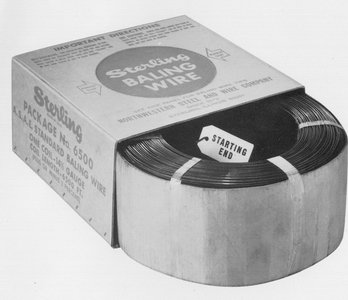The Bale Tie and Coiled Wire Process, as it was done in 1957.
The manufacturing of bale ties at Northwestern Steel & Wire Company was an important item in the company’s project line. Bale ties users were many, including farmers, manufacturers, merchants, and other who required the use of this particular pliable, strong wire.
The following explains how the bale tie and coiled wire department operated as explained in the January 1957 issue of “Northwestern News.”
“This is the story of bale ties and coiled baling wire and how it is produced at Northwestern. Let’s first look at the process involved in the production of bale ties. First, the desired gauges of wire of special analyzed steel is loaded on large reels and then fed through annealing furnaces at controlled temperatures to produce the required pliability and still maintain the strength quality.
“From the furnace the wires pass through a straightening operation and then to the fabricating machine which cuts the ties to the exact length required. From there it automatically forms a single loop or a ‘clinch-hed’ tie. The single loop tie has a loop or eye twisted on one end, therefore making it a simple operation for the user to insert the end of the wire through the loop or eye and twist by hand to secure the bale.
“The ‘clinch-hed’ is a patented bale tie and eliminates the tedious job of hand twisting. The ‘clinch-hed’ tie has a special loop or eye formed on one end of the wire and a head formed on the other end similar to the head of the common nail. The user then needs only to insert the nail head end of the tie through the special loop or eye and the expansion of the bale automatically locks nail heard and eye securely so that it cannot come apart.
“Next the ties are processed through our building machine operations where the bale ties are bundled 250-500 wires each bundle depending on customer requirements. There, a red burlap protective covering is applied to the loop or eye end of the bundle and white burlap protective covering is applied to the tail end of the bundle.
“The entire bundle is then “spiral wrapped” with copper-coated wire for additional protection during handling and shipment to our customers.
“Our bale ties, commonly known as Red Head Gold Band Bale Ties, are produces any desired gauges and lengths to meet the requirements of our customers.
“About 1949, the Manufacturers of Baling Equipment introduced an automatic, self-tying baling machine, that requires the use of annealed wire in coils or spools, which replaces the old hand-fed machines.
“Northwestern has pioneered in the production of this spooled wire for use with automatic self-tying balers.”
Coiled Baling Wire
“In the production of coiled baling wire, the wire, after being drawn from rods to the desired sizes, is then further processed through annealing furnaces to obtain the desired pliability and tensile strength. From there, the wire is re-coiled on our coiling machines into desired coil or spool specifications to meet our customer requirements.
“After the wire is coiled, the coils are sent by conveyor to the packaging end, where they are packed in special cardboard containers and sealed, ready for shipment to the customer.
“For many years, Northwestern has been a leader in quality bale ties and in coiled baling wire from ins inception. The improved production methods and improved quality developed thought these years are proud accomplishments of the men who make this product.
Article taken from the Daily Gazette with some corrections and modifications. Dana Fellows ~ 2011

